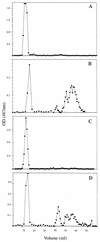Cloning, sequencing, and characterization of the cgmB gene of Sinorhizobium meliloti involved in cyclic beta-glucan biosynthesis
- PMID: 10419956
- PMCID: PMC103589
- DOI: 10.1128/JB.181.15.4576-4583.1999
Cloning, sequencing, and characterization of the cgmB gene of Sinorhizobium meliloti involved in cyclic beta-glucan biosynthesis
Abstract
Periplasmic cyclic beta-glucans of Rhizobium species provide important functions during plant infection and hypo-osmotic adaptation. In Sinorhizobium meliloti (also known as Rhizobium meliloti), these molecules are highly modified with phosphoglycerol and succinyl substituents. We have previously identified an S. meliloti Tn5 insertion mutant, S9, which is specifically impaired in its ability to transfer phosphoglycerol substituents to the cyclic beta-glucan backbone (M. W. Breedveld, J. A. Hadley, and K. J. Miller, J. Bacteriol. 177:6346-6351, 1995). In the present study, we have cloned, sequenced, and characterized this mutation at the molecular level. By using the Tn5 flanking sequences (amplified by inverse PCR) as a probe, an S. meliloti genomic library was screened, and two overlapping cosmid clones which functionally complement S9 were isolated. A 3.1-kb HindIII-EcoRI fragment found in both cosmids was shown to fully complement mutant S9. Furthermore, when a plasmid containing this 3.1-kb fragment was used to transform Rhizobium leguminosarum bv. trifolii TA-1JH, a strain which normally synthesizes only neutral cyclic beta-glucans, anionic glucans containing phosphoglycerol substituents were produced, consistent with the functional expression of an S. meliloti phosphoglycerol transferase gene. Sequence analysis revealed the presence of two major, overlapping open reading frames within the 3.1-kb fragment. Primer extension analysis revealed that one of these open reading frames, ORF1, was transcribed and its transcription was osmotically regulated. This novel locus of S. meliloti is designated the cgm (cyclic glucan modification) locus, and the product encoded by ORF1 is referred to as CgmB.
Figures







Similar articles
-
A novel cyclic beta-1,2-glucan mutant of Rhizobium meliloti.J Bacteriol. 1995 Nov;177(22):6346-51. doi: 10.1128/jb.177.22.6346-6351.1995. J Bacteriol. 1995. PMID: 7592408 Free PMC article.
-
Suppression of the ndv mutant phenotype of Rhizobium meliloti by cloned exo genes.Mol Microbiol. 1992 Feb;6(4):479-88. doi: 10.1111/j.1365-2958.1992.tb01492.x. Mol Microbiol. 1992. PMID: 1560776
-
Synthesis of glycerophosphorylated cyclic beta-(1,2)-glucans by Rhizobium meliloti ndv mutants.J Bacteriol. 1994 Feb;176(4):1047-51. doi: 10.1128/jb.176.4.1047-1051.1994. J Bacteriol. 1994. PMID: 8106315 Free PMC article.
-
Regulation of succinoglycan and galactoglucan biosynthesis in Sinorhizobium meliloti.J Mol Microbiol Biotechnol. 2002 May;4(3):187-90. J Mol Microbiol Biotechnol. 2002. PMID: 11931545 Review.
-
Cyclic beta-glucans of members of the family Rhizobiaceae.Microbiol Rev. 1994 Jun;58(2):145-61. doi: 10.1128/mr.58.2.145-161.1994. Microbiol Rev. 1994. PMID: 8078434 Free PMC article. Review.
Cited by
-
Sinorhizobium meliloti phospholipase C required for lipid remodeling during phosphorus limitation.Proc Natl Acad Sci U S A. 2010 Jan 5;107(1):302-7. doi: 10.1073/pnas.0912930107. Epub 2009 Dec 14. Proc Natl Acad Sci U S A. 2010. PMID: 20018679 Free PMC article.
-
Transcriptome Analysis of Polyhydroxybutyrate Cycle Mutants Reveals Discrete Loci Connecting Nitrogen Utilization and Carbon Storage in Sinorhizobium meliloti.mSystems. 2017 Sep 12;2(5):e00035-17. doi: 10.1128/mSystems.00035-17. eCollection 2017 Sep-Oct. mSystems. 2017. PMID: 28905000 Free PMC article.
-
Fatty acid-releasing activities in Sinorhizobium meliloti include unusual diacylglycerol lipase.Environ Microbiol. 2015 Sep;17(9):3391-406. doi: 10.1111/1462-2920.12814. Epub 2015 Mar 27. Environ Microbiol. 2015. PMID: 25711932 Free PMC article.
-
Osmoregulated Periplasmic Glucans.EcoSal Plus. 2017 Jun;7(2):10.1128/ecosalplus.ESP-0001-2017. doi: 10.1128/ecosalplus.ESP-0001-2017. EcoSal Plus. 2017. PMID: 28593831 Free PMC article.
References
-
- Altschul S F, Gish W, Miller W, Myers E W, Lipman D J. Basic local alignment search tool. J Mol Biol. 1990;215:403–410. - PubMed
-
- Anderson M L M, Young B D. Quantitative filter hybridization. In: Hames B D, Higgins S J, editors. Nucleic acid hybridization: a practical approach. Oxford, England: IRL Press; 1985. pp. 73–111.
-
- Becker A A, Kleickmann A A, Arnold W, Puhler A. Analysis of the Rhizobium meliloti exoH/exoK/exoL fragment: ExoK shows homology to excreted endo-beta-1,3-1,4-glucanases and ExoH resembles membrane proteins. Mol Gen Genet. 1993;238:145–154. - PubMed
Publication types
MeSH terms
Substances
Associated data
- Actions
LinkOut - more resources
Full Text Sources

